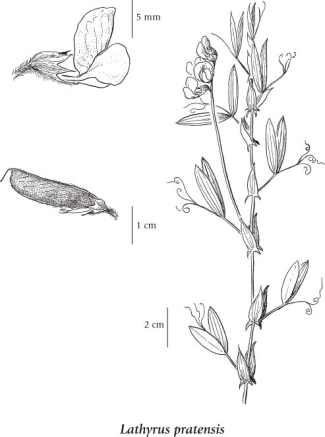Lathyrus pratensis L.
meadow peavine (meadow pea)
Fabaceae (Pea family)
Introduction to Vascular Plants
meadow peavine (meadow pea)
Fabaceae (Pea family)
Introduction to Vascular Plants
Species Information
General:
Perennial herb from a rhizome; stems decumbent to erect, 40-100 cm long, wingless, usually freely branched, usually long silky-hairy.
Leaves:
Alternate, pinnately compound with 2 leaflets; leaflets linear-elliptic, 2-5 cm long; tendrils present but often unbranched and scarcely grasping; stipules often as large as the leaflets, narrowly egg-shaped, lobed, the lower lobes to 1/2 as long as the upper.
Flowers:
Inflorescence a crowded, long-stalked, axillary cluster of 3 to 12 pea-like flowers; corollas yellow, 12-17 mm long, the banner longer than the wings and keel, the banner-claw shorter than the blade; calyces 6-8 mm long, strongly veined, the main veins hairy, the narrowly lanceolate teeth almost as long as the tube.
Fruits:
Pods, 2-3 cm long, 4-7 mm wide, fine-hairy or becoming glabrous; seeds 4 to 8.
Illustration

If more than one illustration is available for a species (e.g., separate illustrations were provided for two subspecies) then links to the separate images will be provided below. Note that individual subspecies or varietal illustrations are not always available.
Illustration Source: The Illustrated Flora of British Columbia
Ecology
Ecological Framework for Lathyrus pratensis
The table below shows the species-specific information calculated from
original data (BEC database) provided by the BC Ministry of Forests and Range.
(Updated August, 2013)
The table below shows the species-specific information calculated from
original data (BEC database) provided by the BC Ministry of Forests and Range.
(Updated August, 2013)
| Site Information |
Value / Class |
||
|
Avg |
Min |
Max |
|
| Elevation
(metres) |
975 | 975 | 975 |
| Slope
Gradient (%) |
65 | 65 | 65 |
|
Aspect (degrees) |
191 | 192 | 192 |
| Soil
Moisture Regime (SMR) [0 - very xeric; 4 - mesic; 8 - hydric] |
2 | 2 | 2 |
| Modal
Nutrient Regime
Class |
D | ||
| #
of field plots species was recorded in: |
1 | ||
| Modal
BEC Zone Class |
SBS | ||
|
All BEC Zones (# of stations/zone) species was recorded in |
SBS(1) | ||
|
Source:
Klinkenberg 2013
|
|||